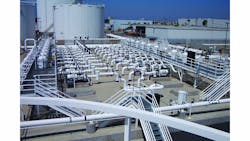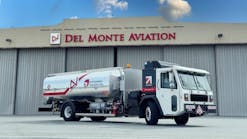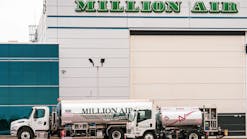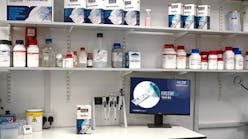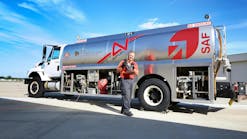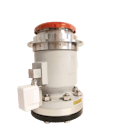How To Properly Store Flammable And Combustible Liquids
Common to all aviation facilities is some form of flammable or combustible liquid storage. How is this storage type determined? Is the storage provided adequate? How can we ensure that fire or other incident will be prevented? Where do we start when specifying, installing, or inspection liquid storage tanks? Guidance on liquid classification, tank types and installation, and fire/spill protection requirements is found in the National Fire Protection Association standard, NFPA 30, Flammable and Combustible Liquids Code. (This document can be viewed for free at, www.nfpa.org/30.)
The first step to determining the storage requirements of the liquids (typically fuel on our aviation facilities, but could also be oils, chemicals, cleaning solutions or the like) on your facility is to clearly define the characteristics of the liquid. Defining the liquid answers these two questions:
- Is this liquid flammable or combustible?
- What class of liquid is this?
To determine the difference between a flammable or combustible liquid, one must first determine the liquid’s flash point. If the liquid has a flashpoint below 100 degrees F, then it is considered “flammable.” Liquids that have a flashpoint at or above 100 degrees F are “combustible.” Determining this information must be completed first, so that the liquid can then be properly classified (as defined in NFPA 30:4.2.2 and 4.2.3).
Flammable liquids are broadly classified as Class I (with sub-classifications) and combustible liquids will be either Class II or Class III (with sub-classifications). The liquids are classified based on their flash points and boiling points.
Flammable liquids:
- Class IA – flash point below 73 degrees F and boiling point below 140 degrees F.
- Class IB – flash point below 73 degrees F and boiling point at or above 140 degrees F.
- Class IC – flash point at or above 73 degrees F, but below 100 degrees F.
Combustible liquids:
- Class II – flash point at or above 100 degrees F and below 140 degrees F.
- Class III – flash point at or above 140 degrees F.
o Class IIIA – flash point at or above 140 degrees F, but below 200 degrees F.
o Class IIIB – flash point at or above 200 degrees F (per NFPA 30:4.3).
There are four primary liquid storage methods:
- Aboveground tanks.
- Underground tanks.
- Storage tank buildings (tanks inside a structure).
- Container/locker storage.
Each of these is designed for a specific use, has clearly defined installation requirements and must be adequately protected against fire, spill and other emergencies.
Aboveground storage tanks come in three variations based on pressures. Atmospheric tanks are rated for pressures of 0 to 1.0 psig. Low-pressure storage tanks can handle up to 15 psig. Anything required above 15 psig must be stored in a pressure vessel. We mostly see atmospheric tanks for housing our JP-8 and other aviation fuels. The higher pressure tanks are required for liquids that have a high vapor pressure. NFPA 30, chapter 22 outlines the construction requirements, clear distances to other structures, and separation between multiple tanks.
Underground storage tanks are widely considered to be the safest form of storage. Ground water and environmental concerns must be considered for this type of installation. And these tanks must be able to withstand the aboveground pressures that they may be subjected to (earth, concrete, structures, traffic). The installation requirements are outlined in NFPA 30, chapter 23. The tank manufacturer’s installation, maintenance, and inspection guidelines must be closely reviewed and followed.
Tanks within a structure, or storage tank buildings, are permitted for the storage of all liquids except for Class IIIB. These tank storage buildings must meet specific construction requirements including, minimum two-hour fire-rated construction, and deflagration venting for explosion protection. The complete construction, site, and protection requirements can be found in NFPA 30, chapter 24.
Liquids that are stored in containers of less than 119 gallons or portable tanks under 660 gallons may be stored in special hazardous materials storage lockers or cabinets. These lockers are moveable and modular, and can safely and cost-effectively meet minimum code requirements. These lockers must remain in their designated area as approved by the local fire official. The construction of these cabinets must meet the requirements of NFPA 30, chapter 9. These can be purchased pre-fabricated, or can be constructed using the guidance provided in this code.
SPECIFIC REQUIREMENTS
Each of these storage options has specific fire protection requirements. Some require fixed fire protection systems, such as fire sprinklers, water mist, water monitors, or fire alarm systems. Others do not require this.
However, NFPA 30 outlines general fire safety and emergency response procedures that must be met for any flammable or combustible liquid storage configurations.
For example, open flames, lightning, smoking, cutting and welding or static electricity can be the primary contributing factor to a flammable or combustible liquids fire. Every precaution should be taken to control ignition sources. Smoking should be prohibited or only allowed in designated and clearly identified areas. Combustible waste and vegetation should be cleared from the storage area. A hot work permit program should be in place and strictly enforced for all personnel performing hot work on, or around, the liquid containers and tanks. All metallic tanks, piping, or other components are required to be bonded and grounded.
Although there is no specific fire alarm requirement, NFPA 30 does state that, “... prompt notification of fire or emergency to those within the plant and to the … fire department shall be provided.” (NFPA 30:6.6.1.)
One method of meeting this requirement would be to install a fire alarm system. Any area where a spill potential exists should be monitored by patrolling/observation personnel, spill indicating and monitoring equipment, or gas detectors that continuously monitor the area.
Regardless of the presence or requirement of a fire sprinkler system, a reliable water supply must be available. The water supply is required to meet the pressure and quantity demands that the hazardous liquid storage requires. The water supply also must be prevented from becoming contaminated by any process systems that may be present.
An emergency action plan that addresses all possible hazards and events should be in place. These emergency plans should include the proper procedures for sounding an alarm, notifying the fire department, evacuating personnel, and controlling or extinguishing a fire. Specific personnel should be assigned duties that must be performed in the event of an emergency. Procedures for operating and maintaining fire protection equipment should be clearly outlined, shut down procedures for liquid storage or transfer operations should be listed. This plan must be regularly reviewed and practiced. Exercises should be conducted for all responsible personnel to ensure that initial and ongoing training is received.
About the Author: Aaron Johnson has been in the fire protection and life safety industry for nearly 10 years. He began his career as a firefighter, then transitioned to fire prevention. He currently serves as fire marshal for a Fortune 100 aircraft manufacturing corporation. He also blogs about fire protection and life safety issues at www.TheCodeCoach.com.
